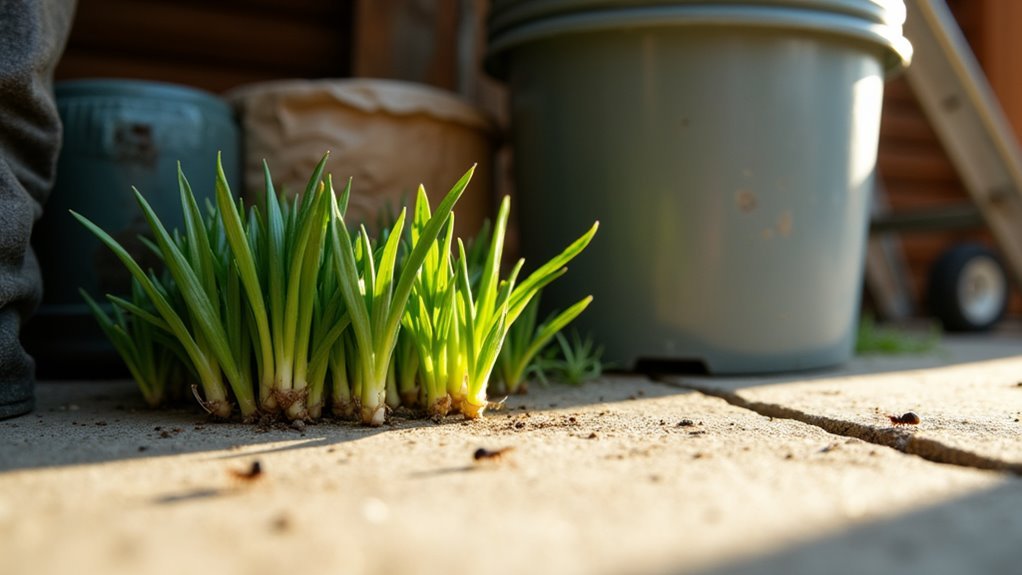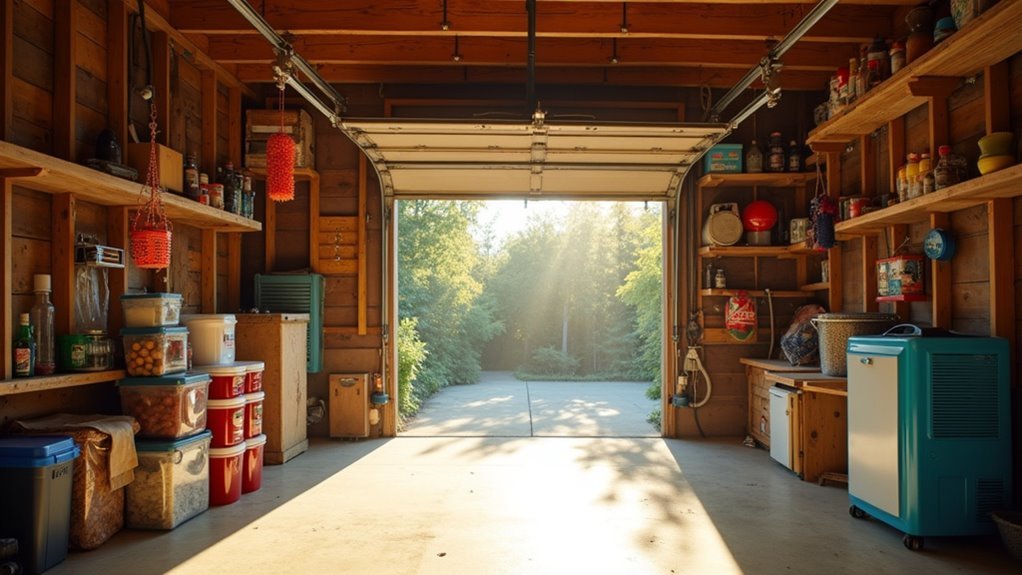You’ll need to tackle garage pests during five critical seasons: early spring requires sealing cracks and controlling moisture to prevent ant invasions and termite swarms, late spring through early summer demands eliminating standing water and managing flying insects, peak summer calls for maximum moisture control and food source management when pest populations reach their highest levels, early fall is your last chance to seal entry points before rodents seek winter shelter, and winter months require vigilant monitoring for indoor invaders while maintaining all preventive measures you’ve established throughout the year.
Early Spring: Preventing Ant Invasions and Termite Swarms in Your Garage

As winter’s chill fades away, your garage becomes a battleground where emerging ants and termites wage their annual invasion. Early spring triggers ant invasions as these pests desperately search for food and nesting sites, entering through tiny cracks in your garage walls.
Spring awakens hungry ants and termites, transforming your peaceful garage into their preferred hunting ground for food and shelter.
Meanwhile, termite activity escalates with swarming season approaching, making early detection essential for preventing major infestations.
Implementing proactive pest control starts with sealing cracks and maintaining proper moisture control, since both pests gravitate toward damp environments.
Store food items, pet supplies, and organic materials in airtight containers to eliminate attractive food sources.
Regular inspections help you spot mud tubes or discarded wings before problems escalate.
Effective pest management requires seasonal treatments and consistent monitoring to keep your garage pest-free throughout spring’s challenging months.
Late Spring to Early Summer: Managing Flying Insects and Establishing Breeding Controls
When temperatures rise in late spring, flying insects transform your garage into their preferred breeding headquarters.
You’ll face increased activity from mosquitoes, flies, and wasps seeking ideal breeding grounds. Proactive management becomes essential to prevent infestations before they establish.
Eliminate standing water around your garage immediately—mosquitoes can lay hundreds of eggs in minimal stagnant water.
Focus on sealing entry points by inspecting and repairing cracks in doors and windows to stop wasps from nesting inside.
Effective pest control methods include:
- Implementing integrated pest management with specialized traps and baits for flying insects
- Maintaining cleanliness by removing garbage and spilled liquids that attract flies
- Regularly inspecting potential breeding grounds around your property
- Using targeted treatments for specific insect populations
Remove food sources consistently, as decaying organic matter draws various pests during peak activity periods.
Peak Summer: Combating High-Activity Pests With Moisture and Food Source Management

Peak summer months bring the year’s most challenging pest activity to your garage, with mosquitoes, ants, and cockroaches reaching maximum population levels. These high-activity pests exploit moisture and food sources, making targeted management essential for preventing pests from establishing colonies.
Moisture control forms your primary defense against garage pests during summer months. Fix leaks immediately and use dehumidifiers to eliminate the damp conditions that attract cockroaches and termites.
| Prevention Strategy | Implementation |
|---|---|
| Moisture Control | Fix leaks, use dehumidifiers |
| Food Source Management | Store items in airtight containers |
| Regular Cleaning | Vacuum and declutter weekly |
| Seal Entry Points | Inspect and caulk cracks |
Food source management requires storing everything in airtight containers and disposing waste promptly. Regular cleaning disrupts pest habitats, while sealing entry points prevents pest infestations from spreading indoors.
Early Fall: Sealing Entry Points Before Rodents Seek Winter Shelter
Before temperatures drop and rodents begin their desperate search for warm shelter, early fall presents your most critical window for sealing entry points around your garage.
Mice can squeeze through gaps as small as a nickel, making thorough inspection vital for effective pest prevention. You’ll need to examine foundations, doors, and windows carefully for potential access points.
- Use steel wool or caulk to seal gaps in foundations and around window frames
- Check garage doors for wear and guarantee they close tightly against the threshold
- Inspect areas where utilities enter your garage for small cracks or openings
- Focus on corners and baseboards where rodents commonly find entry points
These preventive measures for home protection dramatically reduce infestations when rodents actively seek shelter, proving more effective than addressing problems after they’ve established themselves inside.
Winter Months: Monitoring for Indoor Invaders and Maintaining Preventive Measures

Once winter arrives and temperatures consistently drop, your vigilance must shift from prevention to active monitoring as pests establish themselves in the warmth of your garage.
Winter pest control requires a proactive approach since mice, cockroaches, and spiders actively seek indoor shelter during cold months. You’ll need regular monitoring to catch signs of pest activity early—look for droppings, gnaw marks, and unusual odors.
Early detection is crucial during winter months when pests infiltrate warm indoor spaces seeking refuge from freezing temperatures.
Maintain your clutter-free garage to eliminate hiding spots and make inspections easier. Continue sealing entry points you might’ve missed, remembering mice squeeze through nickel-sized openings.
Reduce moisture sources that attract cockroaches, and deploy traps strategically. Your preventive measures must remain consistent throughout winter, as hidden infestations can quickly establish without proper pest entry controls and ongoing surveillance.
Frequently Asked Questions
What Month Is Best for Pest Control?
You’ll find April through June works best for pest control since pests become active after winter. However, you should schedule treatments before seasonal changes to prevent infestations rather than react to them.
What Season Are Pests Most Active?
You’ll find pests are most active during spring and summer months. Warmer temperatures boost populations of ants, mosquitoes, and stinging insects notably. That’s when you’ll encounter the highest pest activity levels overall.
How to Pest Proof a Garage?
Seal cracks with caulk, store food in airtight containers, declutter regularly using sealed bins, keep it dry with proper ventilation, and install door sweeps plus window screens for barriers.
Should You Do Pest Control in Winter?
You should absolutely do pest control in winter. Rodents and insects seek warm shelter in your home during cold months. Winter inspections reveal hidden infestations, preventing larger problems when spring arrives.
In Summary
You’ve now got a year-round strategy that’ll keep your garage pest-free through every season. Don’t wait for infestations to start—stay ahead by implementing these preventive measures before pests become problems. Remember, consistency matters more than perfection. Check your garage monthly, maintain clean conditions, and seal any new entry points you discover. With this seasonal approach, you’ll transform your garage from a pest haven into a protected space that stays secure year-round.





Leave a Reply